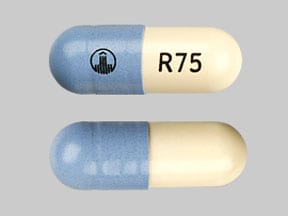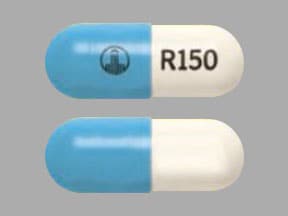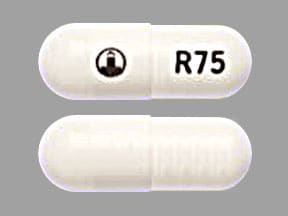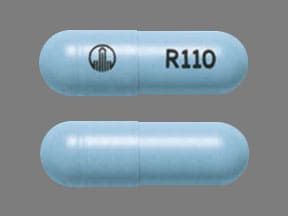What are Pradaxa capsules?
Pradaxa is a prescription medicine that is used to:
- in adults:
- reduce the risk of stroke and blood clots in adults who have a medical condition called atrial fibrillation that is not caused by a heart valve problem. With atrial fibrillation, part of the heart does not beat the way it should. This can lead to blood clots forming and increase your risk of a stroke.
- treat blood clots in the veins of your legs (deep vein thrombosis) and lungs (pulmonary embolism) after you have been treated with an injectable medicine to treat your blood clots for 5 to 10 days.
- reduce your risk of blood clots from happening again in the veins of your legs (deep vein thrombosis) and lungs (pulmonary embolism) after you have received treatment for blood clots.
- help prevent blood clots in your legs (venous thrombosis) and lungs (pulmonary embolism) after you have just had hip replacement surgery.
- in children:
- treat blood clots in children 8 years to less than 18 years of age who have received an injectable medicine to treat their blood clots for at least 5 days.
- reduce the risk of blood clots from happening again in children 8 years to less than 18 years of age who have received treatment for blood clots.
It is not known if Pradaxa capsules are safe and effective in children with atrial fibrillation not caused by a heart valve problem, or in children who have undergone hip replacement surgery.
What is the most important information I should know about Pradaxa capsules?
- People with atrial fibrillation (a type of irregular heartbeat) are at an increased risk of forming a blood clot in the heart, which can travel to the brain, causing a stroke, or to other parts of the body. Pradaxa lowers your chance of having a stroke by helping to prevent clots from forming. If you stop taking Pradaxa, you may have increased risk of forming a clot in your blood.
Do not stop taking Pradaxa capsules without talking to the healthcare provider who prescribes it for you. Stopping Pradaxa increases your risk of having a stroke.
Pradaxa may need to be stopped, if possible, before surgery or a medical or dental procedure. Ask the healthcare provider who prescribed Pradaxa for you when you should stop taking it. Your healthcare provider will tell you when you may start taking Pradaxa again after your surgery or procedure. If you have to stop taking Pradaxa, your healthcare provider may prescribe another medicine to help prevent a blood clot from forming. - Pradaxa can cause bleeding which can be serious, and sometimes lead to death. This is because Pradaxa is a blood thinner medicine that lowers the chance of blood clots forming in your body.
- You may have a higher risk of bleeding if you take Pradaxa and:
- are over 75 years old
- have kidney problems
- have stomach or intestine bleeding that is recent or keeps coming back, or you have a stomach ulcer
- take other medicines that increase your risk of bleeding, including:
- aspirin or aspirin-containing products
- long-term (chronic) use of non-steroidal anti-inflammatory drugs (NSAIDs)
- a medicine that contains warfarin sodium
- a medicine that contains heparin
- a medicine that contains clopidogrel bisulfate
- a medicine that contains prasugrel
- have certain kidney problems and also take a medicine that contains dronedarone or ketoconazole tablets.
Tell your healthcare provider if you take any of these medicines. Ask your healthcare provider or pharmacist if you are not sure if your medicine is one listed above.
- Pradaxa can increase your risk of bleeding because it lessens the ability of your blood to clot. During treatment with Pradaxa:
- you may bruise more easily
- it may take longer for any bleeding to stop
- unexpected bleeding or bleeding that lasts a long time, such as:
- unusual bleeding from the gums
- nose bleeds that happen often
- menstrual bleeding or vaginal bleeding that is heavier than normal
- bleeding that is severe or you cannot control
- pink or brown urine
- red or black stools (looks like tar)
- bruises that happen without a known cause or get larger
- cough up blood or blood clots
- vomit blood or your vomit looks like "coffee grounds"
- unexpected pain, swelling, or joint pain
- headaches, feeling dizzy or weak
- Spinal or epidural blood clots (hematoma). People who take a blood thinner medicine (anticoagulant) like Pradaxa, and have medicine injected into their spinal and epidural area, or have a spinal puncture have a risk of forming a blood clot that can cause long-term or permanent loss of the ability to move (paralysis). Your risk of developing a spinal or epidural blood clot is higher if:
- a thin tube called an epidural catheter is placed in your back to give you certain medicine
- you take NSAIDs or a medicine to prevent blood from clotting
- you have a history of difficult or repeated epidural or spinal punctures
- you have a history of problems with your spine or have had surgery on your spine
See "What are the possible side effects of Pradaxa?" for more information about side effects.
Who should not take Pradaxa capsules?
Do not take Pradaxa if you:
- currently have certain types of abnormal bleeding. Talk to your healthcare provider before taking Pradaxa if you currently have unusual bleeding.
- have had a serious allergic reaction to any of the ingredients in Pradaxa. See below for a complete list of ingredients in Pradaxa. Ask your healthcare provider if you are not sure.
- have ever had or plan to have a valve in your heart replaced with a mechanical (artificial) prosthetic heart valve
What should I tell my healthcare provider before taking Pradaxa capsules?
Before taking Pradaxa, tell your healthcare provider about all of your medical conditions, including if you:
- have kidney problems
- have ever had bleeding problems
- have ever had stomach ulcers
- have antiphospholipid syndrome (APS)
- are pregnant or plan to become pregnant. It is not known if Pradaxa will harm your unborn baby. Tell your healthcare provider right away if you become pregnant during treatment with Pradaxa.
Females who are able to become pregnant: Talk with your healthcare provider about pregnancy planning during treatment with Pradaxa. Talk with your healthcare provider about your risk for severe uterine bleeding if you are treated with blood thinner medicines, including Pradaxa. - are breastfeeding or plan to breastfeed. It is not known if Pradaxa passes into your breast milk. You should not breastfeed during treatment with Pradaxa Capsules. Talk to your healthcare provider about the best way to feed your baby during treatment with Pradaxa Capsules.
Tell all of your healthcare providers and dentists that you are taking Pradaxa. They should talk to the healthcare provider who prescribed Pradaxa for you before you have any surgery or a medical or dental procedure.
Tell your healthcare provider about all the medicines you take, including prescription and over-the-counter medicines, vitamins, and herbal supplements.
Some of your other medicines may affect the way Pradaxa works. Certain medicines may increase your risk of bleeding. See "What is the most important information I should know about Pradaxa?"
Especially tell your healthcare provider if you take a medicine that contains rifampin.
Know the medicines you take. Keep a list of them and show it to your healthcare provider and pharmacist when you get a new medicine.
How should I take Pradaxa capsules?
- Pradaxa comes as capsules and oral pellets. If you have a child who is older than 8 years of age and who is prescribed Pradaxa, your healthcare provider will prescribe the type of Pradaxa that is right for your child.
- Your healthcare provider will decide how long you should take Pradaxa. Do not stop taking Pradaxa capsules without first talking with your healthcare provider. Stopping Pradaxa may increase your risk of having a stroke or forming blood clots.
- Take Pradaxa capsules exactly as prescribed by your healthcare provider.
- If Pradaxa is prescribed for your child, your healthcare provider will determine the correct dose of Pradaxa capsules for your child based on their weight. Your healthcare provider may increase or decrease your child's dose as they grow during treatment and as needed.
- In adults: Take Pradaxa capsules 2 times a day. If you are taking Pradaxa after hip replacement surgery, take Pradaxa 1 time a day.
- In children: Take Pradaxa capsules 2 times a day. Take 1 dose in the morning and 1 dose in the evening about every 12 hours, at about the same time each day.
- You can take Pradaxa capsules with or without food. Taking Pradaxa capsules with food may help if you have an upset stomach.
- Swallow Pradaxa capsules whole with a full glass of water. Tell your healthcare provider if you or your child are not able to swallow the capsules whole. Do not break, chew, or empty the pellets from the capsule.
- Do not run out of Pradaxa capsules. Refill your prescription before you run out. If you plan to have surgery, or a medical or a dental procedure, tell your healthcare provider and dentist that you are taking Pradaxa. You may have to stop taking Pradaxa for a short time. See "What is the most important information I should know about Pradaxa?"
- If you miss a dose of Pradaxa capsules, take it as soon as you remember. If your next dose is less than 6 hours away, skip the missed dose. Do not take two doses of Pradaxa capsules at the same time.
- If you take too much Pradaxa capsules, go to the nearest hospital emergency room or call your healthcare provider.
- Call your healthcare provider right away if you fall or injure yourself, especially if you hit your head. Your healthcare provider may need to check you.
- Pradaxa capsules come in a bottle or in a blister package.
- Only open 1 bottle of Pradaxa capsules at a time. Finish your opened bottle of Pradaxa capsules before opening a new bottle.
- After opening a bottle of Pradaxa capsules, use within 4 months. See "How should I store Pradaxa capsules?"
- When it is time for you to take a dose of Pradaxa capsules, only remove your prescribed dose of Pradaxa capsules from your open bottle or blister package.
- Tightly close your bottle of Pradaxa capsules right away after you take your dose.
What are the possible side effects of Pradaxa capsules?
Pradaxa can cause serious side effects. See "What is the most important information I should know about Pradaxa?"
- Allergic Reactions. Some adults taking Pradaxa Capsules have developed symptoms of an allergic reaction.
- Call your healthcare provider if you or your child gets symptoms of an allergic reaction, such as:
- hives
- rash
- itching
- Get medical help right away if you or your child gets any of the following symptoms of a serious allergic reaction with Pradaxa capsules:
- chest pain or chest tightness
- swelling of your face or tongue
- trouble breathing or wheezing
- feeling dizzy or faint
- Call your healthcare provider if you or your child gets symptoms of an allergic reaction, such as:
Common side effects of Pradaxa in adults and children include:
- indigestion, upset stomach, or burning
- stomach-area (abdominal) pain or discomfort
In children, common side effects also include:
- nausea, vomiting, or diarrhea
Tell your healthcare provider if you have any side effect that bothers you or that does not go away.
These are not all of the possible side effects of Pradaxa.
Call your doctor for medical advice about side effects. You may report side effects to FDA at 1-800-FDA-1088.
Pradaxa capsules Images
General information about the safe and effective use of Pradaxa capsules
Medicines are sometimes prescribed for purposes other than those listed in a Medication Guide. Do not use Pradaxa capsules for a condition for which it was not prescribed. Do not give Pradaxa capsules to other people, even if they have the same symptoms that you have. It may harm them.
This guide summarizes the most important information about Pradaxa. If you would like more information, talk with your healthcare provider. You can ask your pharmacist or healthcare provider for information about Pradaxa that is written for health professionals.
How should I store Pradaxa capsules?
- Store Pradaxa capsules at room temperature 68°F to 77°F (20°C to 25°C).
- After opening the bottle, use Pradaxa capsules within 4 months. Safely throw away any unused Pradaxa capsules after 4 months.
- Keep Pradaxa capsules in the original bottle or blister package to keep them dry (protect the capsules from moisture). Do not put Pradaxa capsules in pill boxes or pill organizers.
- Tightly close your bottle of Pradaxa capsules right away after you take your dose.
Keep Pradaxa capsules and all medicines out of the reach of children.
What are the ingredients in Pradaxa capsules?
Active ingredient: dabigatran etexilate mesylate
Inactive ingredients: acacia, dimethicone, hypromellose, hydroxypropyl cellulose, talc, and tartaric acid. The capsule shell is composed of carrageenan, hypromellose, potassium chloride, titanium dioxide, black edible ink, and FD&C Blue No. 2 (150 mg and 110 mg capsules only).
For more information about Pradaxa go to www.pradaxa.com or call Boehringer Ingelheim Pharmaceuticals, Inc. at 1-800-542-6257.





